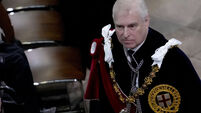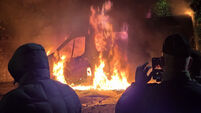Mysterious world of statues in the land of saints and sinners
After all, back in the days when air travel was so expensive and so infrequent that the entire family, when one of their number was going on a plane, accompanied them to the airport in a gesture of solidarity and support, he was huge. Back at the time of the Iron Curtain when no Irish person could set foot in Prague, every second home in this country nevertheless had a little statue of the Infant, prominently displayed.
It was one of the first indications of the striations of social class I recognised as a kid. The more pretensions a family had, the more likely it was that they would refer to the statue with the big crown as “The Infant of Prague,” rather than “The Child of Prague.” As kids, we noticed that subtle difference, not least because of the information vacuum surrounding the little statue. Nobody seemed to know why he figured in Irish households. Nobody ever explained how the Baby Jesus in the crib, with nothing on him but a cloth thrown over where he should have had a nappy, got so posh by the age of about seven that he had a big angular crown on him and was solemnly blessing us.
I was mystified by the whole thing. Every time the priest at Mass preached about Christ as a child, I was egging for him to explain how the little lad got from Nazareth to Prague. I knew it had to have been no more than a visit – maybe a summer holiday – because the rest of his story was set so firmly outside of Europe. I figured it was part of the bid for freedom the child made around the time when he lectured the priests in the temple, because, other than that episode, he seemed to have behaved himself pretty well as a kid. His family legend didn’t include episodes like mine that began with my mother saying “Will you ever forget the night Terry went off with that four-year-old to watch the horse-racing in Laytown? Miracle the two of them weren’t trampled to death. I’ll never get over it.”
The Virgin Mary didn’t seem to have had many episodes during her son’s childhood that would have left her as traumatised as my mother seemed to have been, and yet her child had – before air travel – apparently got himself to Prague, achieved iconic status there (long before “iconic status” applied to any nonentity whose photograph ever appeared in a tabloid newspaper), and then got back to where he came from to get on with the main story of his life.
No, the Child of Prague stood in most households, shorn of backstory. Shorn of physical integrity, too. The fact that the statue consisted, essentially, of two pyramids, the larger, bottom one made up of the marble rendition of the little monarch’s robes, the top one made up of his angular crown, meant that the smallest accident separated one bit from the other bit. Because these accidents happened before Superglue was invented, and because it would have been a sin to feck the two separated chunks into the bin, the favoured way of keeping the Infant semi-intact was to ram a pencil down the hollow in the middle, making sure it was tall enough to hold the head on. It was tacitly understood within families that the pencil holding the Infant of Prague together, usually on that bit of the banister at the first floor landing, was somehow sanctified by function. No matter how desperate you were for a writing implement, you couldn’t ever use that one.
The oddity of iconography, back then, was how a generation decided that one particular saint deserved to be present, in statues or pictures or in some cases both, in houses the length and breadth of Ireland, even though the homeowners were possessed of only the sketchiest biographical details about the holy figure. A distant cousin-in-law, encountering a statue of St Martin de Porres when briefly living in England where his father was working at the time, announced that it was St Patrick. The rest of the family, surprised, pointed to the relative darkness of the skin of the saint as portrayed. The little boy, who had clearly grasped the principles of air pollution, described with enthusiasm and logic that St Patrick got dirtied in Britain.
“He’s like an engine driver since he came over to Manchester,” he explained.
I’m quite sorry for kids today who don’t have their homes filled with statues. I used to love checking out the statues in houses we’d visit. Some of them had plastic Virgin Marys with crowns that doubled as screw-tops to allow access to the Lourdes water inside, although it was understood that although you could open the crown, you didn’t really lash the holy water around because it was a higher grade than you could get locally and therefore needed to be preserved for application when someone in the family was seriously injured or sick.
Some had renditions of the Virgin Mary, looking downcast but resigned, as she always seemed to do, with one bare foot planted on a snake representing Satan. The snake was always positioned so his head was turned, forked tongue extended, just near enough to her to give her an awful bite on the ankle or shin. I always wanted to tell her to move her foot up a bit so she was standing either directly on his head (although that might make a discomfiting bony crunch) or just behind his head, thereby depriving him of oxygen and mobility simultaneously.
Any family where one of the girls was named Therese or Teresa had a statue of the Little Flower, her tiny round child’s face imprisoned inside a nun’s wimple, standing, not on a snake, but on pink roses.
My all-time favourite statue was a luminous version of the Holy Family, about the size of a small apple, that sat on a table beside my bed. During the day, it was fairly pallid, with that greenish hue of whatever kind of material provides a faint glow at night. But once darkness fell, that statue came into its own. If you tented the bedclothes over it and held your book close enough to the faint glow, you could keep reading long after official bed time. Nor did it trouble your conscience. Well, it didn’t trouble MY conscience to continue to read What Katy Did Next at ten o’clock when my parents believed I’d been fast asleep for hours. I figured the Holy Family, if they didn’t approve of what I was doing, would have turned off their glow.
The one rendition of Christ I really didn’t like was in my parents’ room. It was a huge, elaborately framed black and white picture of Christ in a long white robe. He was pale and depressed looking and his eyes followed you reproachfully around the room, so you knew that if he glowed in the dark, he’d turn himself off rather than let you read by his light. At about waist level, printed words said “Sterrer Pinx.” I never found out whether this was a quotation or the name of the artist.
That figure of Christ appeared, like the Child of Prague, in countless homes thoughout the country and now turns up in charity shops as the possessions of dead pensioners find their way there for re-sale. The man in my life, spotting a large version of the picture in a VdeP shop recently, was reminded of his younger brother’s reaction, at six, to the visual of Christ, pointing at his own exposed heart with one hand while holding a globe with the other.
“Poor God,” the little boy said sympathetically. “Poor God. Nobody will play football with him.”















